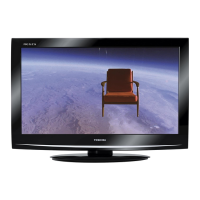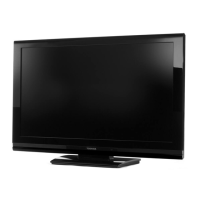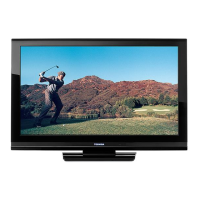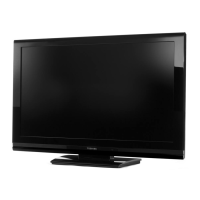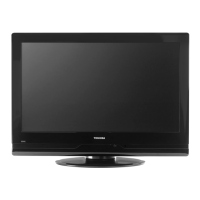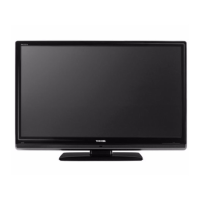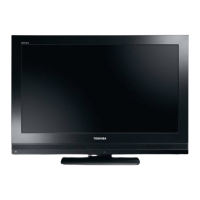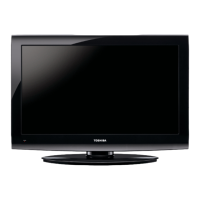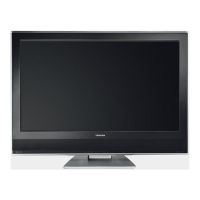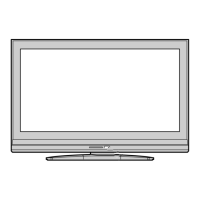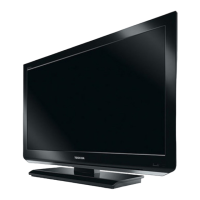
Do you have a question about the Toshiba 26AV733G and is the answer not in the manual?
| Audio system | Dolby Volume |
|---|---|
| Speakers | 2x 5W |
| Power requirements | 220-240V, 50/60Hz |
| Headphone connectivity | 3.5 mm |
| Comb filter | Digital |
| Response time | 8 ms |
| Display diagonal | 26 \ |
| Display brightness | 450 cd/m² |
| Display resolution | 1366 x 768 pixels |
| Display technology | LCD |
| Native aspect ratio | 16:9 |
| Contrast ratio (dynamic) | 30000:1 |
| Game mode | Yes |
| RGB ports quantity | 1 |
| SCART ports quantity | 2 |
| USB 2.0 ports quantity | USB 2.0 ports have a data transmission speed of 480 Mbps, and are backwards compatible with USB 1.1 ports. You can connect all kinds of peripheral devices to them. |
| Product color | Black |
| Power consumption (standby) | 0.5 W |
| Power consumption (typical) | 90 W |
| Tuner type | Analog & digital |
| Depth (with stand) | 265.2 mm |
|---|---|
| Width (with stand) | 666 mm |
| Height (with stand) | 474.6 mm |
| Depth (without stand) | 93.5 mm |
| Height (without stand) | 429 mm |
Ensure adequate clearance for TV ventilation to prevent overheating.
Avoid direct sun, heaters, and extreme temperatures to prevent damage.
Use only the correct mains lead and ensure safe electrical connections.
Important warnings for safe operation, including covers, plugs, and general use.
Proper placement for viewing, ventilation, and securing the TV.
Toshiba's liability limitations for product loss or damage.
Information on digital reception and potential image retention.
Alerts to hazardous electrical voltage within the enclosure.
Highlights important operating and maintenance instructions.
Advises keeping open flames away from the product.
Explanation of each button's function on the remote control.
Detailed functions of colour buttons for text and picture modes.
Instructions for inserting batteries and warnings about mixing types.
Optimal operating distance and angle for the remote control.
Turn off power before connecting any external equipment.
Connecting VCR, decoder, and media recorder via SCART.
Connecting audio signals using phono sockets.
Connecting digital audio to a home theatre system.
Connecting HDMI devices for digital audio and video.
Controlling connected equipment using the TV remote.
Basic control of A/V equipment via TV remote.
Refer to manuals for connected devices for proper operation.
Returning to TV mode or recalling external equipment.
Diagrams showing HDMI connections for 19/22 and 26/32/40 models.
Using branded HDMI cables; REGZA-LINK compatibility notes.
Receives digital audio/video from HDMI or DVI sources.
Accepts HDCP material; details on acceptable video signal formats.
Use HDMI cable with HDMI Logo for proper operation.
Diagrams for connecting HDMI devices to 19/22 and 26/32/40 models.
Diagram showing DVI device connection to HDMI input.
Use adapter cable and separate audio cables for DVI connection.
Recommended cable length and video-only transfer.
Diagrams for connecting DVI devices via HDMI for 19/22 models.
Using HDMI-to-DVI adapter and audio cables for PC connection.
Using HDMI cable for PC with HDMI terminal.
Diagrams for PC connection to HDMI for 19/22 and 26/32/40 models.
Recommended procedures for resetting HDMI or DVI devices.
List of supported video formats and frequencies for HDMI.
Supported PC signal formats and resolutions for HDMI/D-SUB.
Notes on PC input support and signal resolution display.
Using the remote control for adjustments and functions.
Using the common interface for conditional access modules.
Diagrams showing controls and LEDs for Models 19/22 and 26/32/40.
Steps for initial power on, including aerial and input setup.
Putting the TV into standby and turning it back on.
Navigating the on-screen menus using the remote control.
Using side panel buttons for volume, channel, and input selection.
Steps for initial setup, including country and language selection.
Starting the automatic channel scan process.
Confirmation of setup and notes on scan skipping and time setting.
Completely re-tuning the TV and updating channel lists.
Steps to perform an automatic channel scan.
Choosing between Full, Quick, and Advance scan modes.
Specific settings for Advance scan mode.
Searching for new channels not in the current list.
Scanning single RF channels and checking signal quality.
Selecting a preferred network when multiple are detected.
Manual tuning for poor reception or alternative systems.
Steps to perform analogue manual scan, including frequency entry.
Blocking programmes from appearing in the programme list.
Steps to skip specific channels.
Changing the order of programmes in the list.
Editing channel numbers and names.
Decoding Canal+ channels and viewing un-encrypted programmes.
Adjusting frequency for better reception of analogue channels.
Removing all channels from the list.
Accessing pay services using a Conditional Access Module (CAM).
Resetting TV settings to original factory values.
Setting the TV to turn off automatically after inactivity.
Using numbered buttons or P buttons to select programmes.
Showing programme position, input mode, or stereo/mono signal.
Viewing the current time from broadcast data.
Selecting Stereo, Dual, or Mono audio channels.
Quickly accessing Picture Mode, Sleep, REGZA-LINK, and Media Player.
Adjusting TV volume and muting sound.
Steps to adjust balance, bass, and treble settings.
Enriching sound quality with expanding and deepening effects.
Reducing volume differences between channels.
Enhancing sound depth with strong bass.
Adjusting the level of Bass Boost.
Providing narration for visually impaired viewers.
Selecting Normal, Hard of Hearing, or Visually Impaired.
Adjusting audio description volume for visually impaired users.
Creating enhanced surround sound with deep bass.
Settings for HDMI audio, Lip Sync, and SPDIF Type.
Shows picture without over scan via HDMI.
For widescreen DVDs, tapes, or broadcasts with potential black bars.
Reduces black bars on 'all sides panel format' by zooming.
Displays true 4:3 aspect ratio broadcasts.
Stretches 4:3 images to fit screen, may cause distortion.
Raises picture for letterbox format broadcasts with subtitles.
For viewing 14:9 broadcasts.
Display settings for PC connections.
Non-scaling display with side/top/bottom bars.
Table showing picture size availability by screen mode.
Selecting preset picture appearance based on programme category.
Adjusting basic picture parameters.
Increasing or decreasing picture sharpness.
Adjusting warmth or coolness of the picture.
Improving screen clarity by adjusting back light.
Selecting Cool, Medium, Warm, or User preference.
Noise reduction features for weak signals and MPEG.
Edge sharpening and smooth motion for movies.
Adjusting brightness/contrast for colour depth.
Optimising backlighting for dark scenes.
Turning screen blue and muting sound when no signal.
Enabling Base Colour Adjustment feature.
Adjusting individual colours for personal preference.
Adjusting base colours (Red, Green, Blue, etc.).
Adjusting horizontal and vertical picture position.
Adjusting PC input signals via VGA.
Setting RGB output range (16-235 or 0-255).
Category 2 cable needed for advanced HDMI features.
Setting TV time based on time zone and broadcast signal.
Option available for Spain/Portugal with Time Zone set to As Broadcaster.
Automatic time setting or manual adjustment.
Setting timers for automatic TV power on/off.
Setting the TV to turn off automatically after a preset time.
Selecting timer duration from Off to 120 Minutes.
Defining input/output sockets for connected equipment.
Manual selection of input if automatic switching fails.
Input selection lists for Model 19/22 and 26/32/40.
Specifying signal type for SCART input.
Selecting Auto, Mixed, RGB, Composite, or S-Video.
Uses CEC technology for controlling Toshiba equipment.
Controlling connected REGZA-LINK equipment via TV remote.
Features controllable by connected equipment.
Icon appears for CEC devices, allowing individual device selection.
Selecting input source with REGZA-LINK icon.
Selecting a specific REGZA-LINK device from a list.
Controlling connected REGZA-LINK devices via TV remote.
Using remote control keys as guided by the control panel.
Enabling individual REGZA-LINK features via setup menu.
Automatically powers TV and switches source for connected equipment.
Switches connected equipment to standby when TV goes standby.
Adjusting volume/mute for speakers connected via AV amplifier.
Ensuring AV amplifier is selected for sound output.
Adjusts widescreen formats and picture preferences for REGZA-LINK PCs.
Enabling REGZA-LINK to activate other functions.
Turning Enable REGZA-LINK On or Off.
Automatically switches off connected REGZA-LINK equipment.
Allows TV remote to control amplifier features.
Setting audio output to TV or AV amplifier speakers.
Opening the Media Player application.
Viewing images simultaneously in a grid.
Navigating and browsing photos in Multi View.
Options for sorting, size, and browsing photos.
Displaying images as an automatic slideshow.
Controls for slideshow playback, duration, and effects.
Viewing music files in a grid.
Playing music files from a USB storage device.
Controls for music playback, pause, and methods.
Options for sorting, size, and browsing music files.
Setting analogue subtitles on or off.
Selecting subtitle languages for digital broadcasts.
Choosing between Normal and Hearing Impaired subtitles.
Selecting soundtrack language for programmes.
Selecting Stereo, Dual, or Mono audio channels.
Automatically displaying widescreen format programmes.
Stretching 4:3 aspect ratio in widescreen format.
Adjusting side panel lightness/darkness for 4:3/14:9.
Speeding up video response for game applications.
Blocking channels or programmes for children.
Accessing parental controls requires a 4-digit password.
Function to block specific channels.
Preventing children from watching programmes by rating limit.
Setting age rating for programme blocking.
Disabling specific external input signals.
Changing the 4-digit parental control password.
Locking TV control buttons, allowing remote-only control.
Resets all TV settings, including channels, to original values.
Shows programme and event details.
Using '+' to display info, and 'again' to close.
Displays programme details and event information.
Navigating guide details and events.
Setting or cancelling timers for programmes via the guide.
Automatic download of new TV software.
Automatic installation of new software.
Manually upgrading TV software over the air.
Checking the version of installed TV software.
Setting the teletext language.
Accessing pages, revealing text, holding, enlarging, and toggling modes.
Troubleshooting steps for no sound or picture.
Ensuring hard of hearing option is not selected for DTV sound.
Checking connections and input selection for video sources.
Checking volume and mute settings for sound issues.
Ensuring correct input (S-VIDEO/AV) is chosen.
Interference, weak signal, or trying different stations.
Checking batteries are correctly inserted and functional.
Removing permanent messages from the screen.
Ensuring strong broadcast signal and checking aerial.
Selecting broadcasting channel for text display.
Using correct HDMI cables for proper operation.
Subtitles not broadcasted or available.
Checking if the digital programme broadcasts digital text.
Using universal password 1276 to reset.
TV turns off after 15 mins without input signal to save power.
Checking VESA DPMS support and exiting DPMS mode.
Ensuring the 'Country' setting is correct.
Troubleshooting REGZA-LINK device connection problems.
Logo disappears after approximately one minute when disconnected.
List of broadcast systems and channels by country.
Screen dimensions and sound output power.
Power usage and supported input/external connection types.
Physical specs, weight, and included items.
Recommended operating temperature and humidity.
Describes independent software components and copyrights.
Explains EULA requirements and Toshiba's warranty for software.
Assumes risks for software quality and performance.
Copyright information for The FreeType Project.
ICU License terms and conditions.
Registered trademarks for DVB/HDMI and printing details.
Instructions for cleaning the screen and cabinet.
Disposal guidelines for products and batteries in EU member states.
Explanation of symbols for battery disposal and chemical content.
